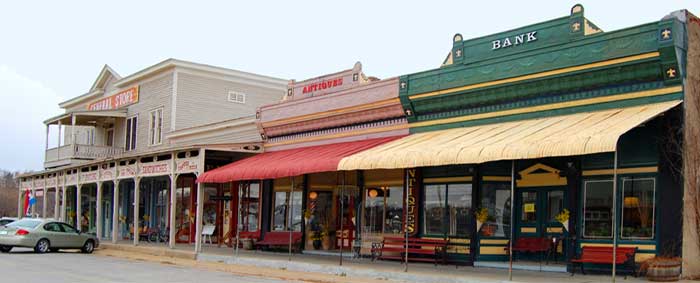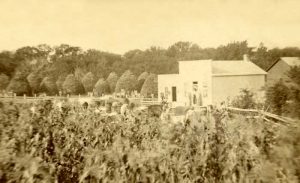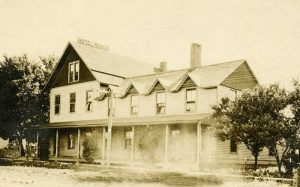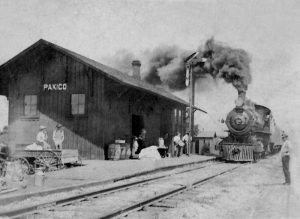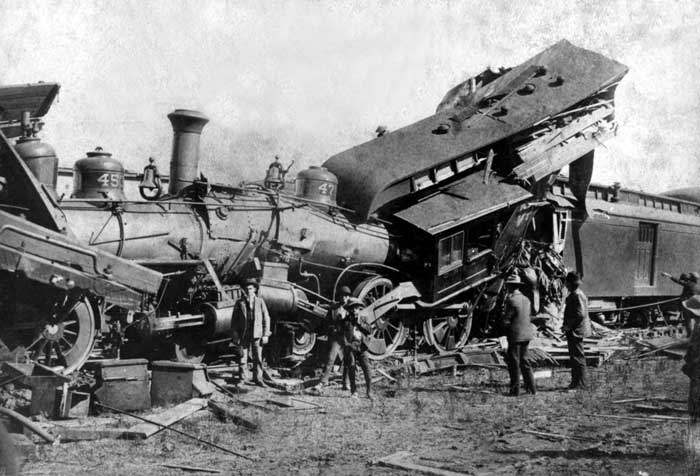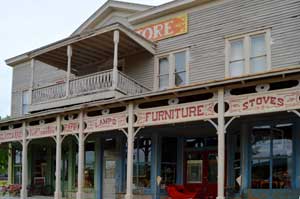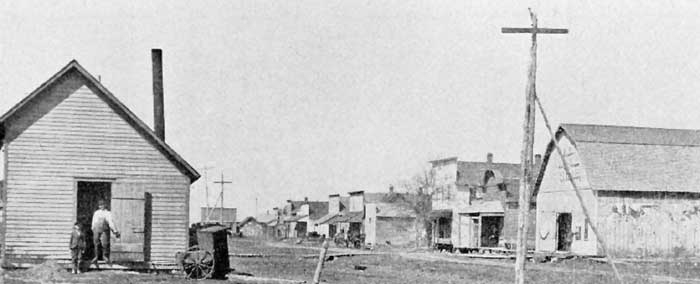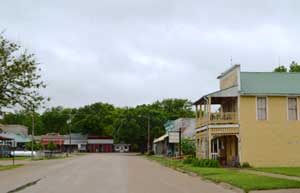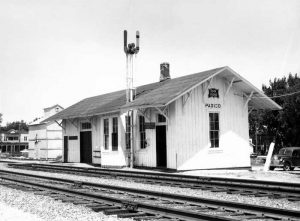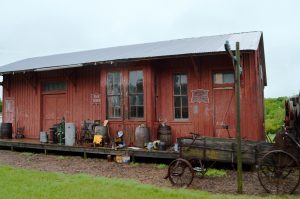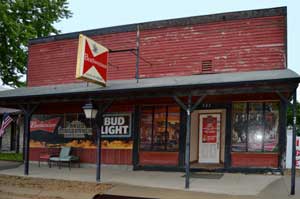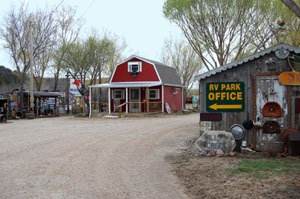Paxico, Kansas is a small town located on Mill Creek in Wabaunsee County, Kansas. A fine example of a rural market town established during the period of rural-agricultural dominance (1865-1900) in Kansas history, Paxico’s Historic District displays a number of well-kept and restored buildings from this era.
This region, along with much of Kansas, was unorganized territory with various Indian reservations in 1850. However, that changed when Kansas Territory was opened to white settlement on May 30, 1853. Richardson County was one of the 33 counties created by the first territorial legislature in 1855, however, the land in the northeastern quarter of the county was part of the Potawatomi Indian Reservation and no settlement was immediately allowed. In 1859, the county’s name was changed to Wabaunsee in memory of Potawatomi chief “Wabonsee,” which meant “The Dawn of Day.” In 1868, the Indian lands were exchanged for a smaller permanent reservation and the next year, the reserve was opened to white settlement. The Federal government also sold part of the land to the Santa Fe Railroad Company for $1 an acre in an effort to attract settlers and establish towns.
The first location of Paxico was established on the north bank of Mill Creek one mile east of the present-day site. In 1869 John Copp, a farmer, and his wife, Mary, moved to the area. Copp also erected a small store on Snomoko Road to serve the area. In 1876, settlers from the area formed District 59 and a schoolhouse was built, which also served as a community center for the area.
In October 1878, Copp sold a parcel of land on the south bank of Mill Creek to John Riederer and the Strowig brothers, William and Robert. Riederer, an experienced miller, was the father-in-law of Robert Strowig and helped the brothers establish a flour mill on Mill Creek. The three-story mill, built of local limestone in 1879, was first called Strong Mill. However, when a post office was established at the mill site in September 1881, it was named Paxico, in honor of the Potawatomi medicine man Pashqua. The mill operations then became known as the Paxico Milling Company.
When the Santa Fe Railroad decided to build a central route almost 70 miles south of Mill Creek in 1886, the company sold their right-of-way to the Chicago, Rock Island, and Pacific Railroad. On July 17, 1886, voters in Wabaunsee County approved the issuance of railroad construction bonds by a large margin. The Rock Island Railroad chose a route along Mill Creek between the two original settlements of Newbury and Paxico. Residents then agreed to establish a new community south of Newbury and northwest of the mill complex on Mill Creek.
A site on the Gerhard and Regina Nuttman farm was platted as the permanent location. The new town would also be called Paxico, and the original settlement then became known as “Old Paxico.”
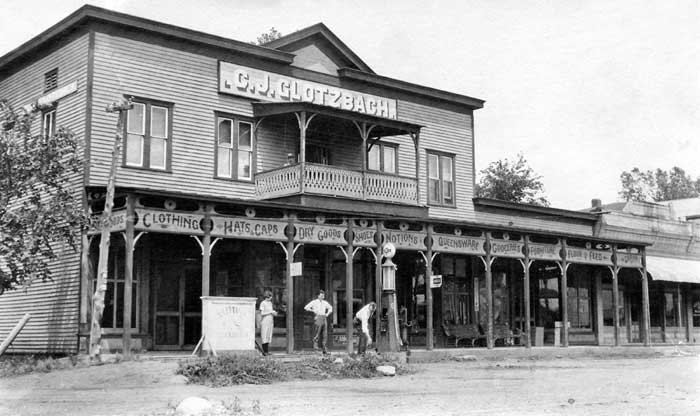
Glotzback Store in Paxico, Kansas, 1920. This was originally the Bolton Brothers Store that was built in 1887. The building still stands today.
The Paxico Town Company was chartered on December 30, 1886, by George F. Anderson (from St. Mary’s, Kansas), C.L. Brownell, and Wesley S. Bolton. When the railroad was constructed through the valley in March 1887, the old Paxico post office and Copp’s store moved to the new site. Within no time, businesses, buildings, and many residents of Newbury and Old Paxico moved to the new site.
The first new building to go up was the Bolton Brothers General Store which was built by C.L. Brownell and George F. Anderson who were both part of the Paxico Town Company, and William S. Bolton of Newbury. All were described as “experienced merchants” with an extensive acquaintance in this part of Wabaunsee County. After purchasing three lots on the west side of the town near the railroad tracks, the investors began to build the two-story general store building with an attached one-story section that was used as a storeroom in the spring of 1887. Though the store was officially owned by Anderson & Co, it was actually operated by William and Ida Bolton and his brother, Ben, hence the name. The large two-story general store located at the south end of Newbury Avenue was an economic and architectural landmark in the town. Today, this historic building continues to stand in Paxico and is part of its historic district.
These men were also the proprietors of the new Paxico Hotel that opened a short time later. This hotel was originally located in Newbury but after the railroad came through, the building was moved to 201 Newbury in Paxico. The building, that once stood where the post office is today, is gone.
The same year, Mr. Winkler and A.R. Strowig purchased lots to build a lumber yard and plans were made to move the wagon and blacksmith shop from Old Paxico to the new townsite. George Banniger had also purchased the Union Hall at Old Paxico and planned to move it to the depot location for his store and post office.
By 1888, Paxico had a full range of local businesses including a wagon and buggy repair shop, blacksmiths, three general stores, a drug store, a meat market, a boot and shoe repair shop, a barber, two physicians, a grain elevator, and the railroad depot. A new wooden school building was also built this year.
“No town has more glowing prospects for developing. We have a beautiful and healthy location, we’re fortunate in richness of territory, and we enjoy a prosperous and energetic class of people. Our population is bound to increase with great rapidity. No one who locates here can make a mistake in doing so. We have a fine general store, a hotel, blacksmith shop, and the depot is nearly completed. This is the time to make investments and open up businesses.”
— First issue of the Paxico Courier
Paxico had two newspapers, but only for brief periods. The Courier operated from August 30, 1888 to September 1, 1889, when the newspaper was purchased and moved to Alma by Matt Thomson. Later, the Paxico Picayune was published from November 1904 to February 24, 1905.
The Grade School was organized in 1888. Paxico High School was formed in 1909, and a brick school building was erected in 1922. The high school closed in 1974.
In 1895, the Chicago, Rock Island and Pacific Railway wrecked about 400 ft west of Depot at Paxico, killing three men. By this time, Paxico was called home to about 175 people and boasted three general stores — Bolton Brothers, Guth & Company, and M. Oehms. Other businesses in town were the Paxico Lumber and Coal Company, Hotel Paxico, Paxico Roller Mills, John Nuttman’s drugstore, Robert Russell’s restaurant, Richard Simpson’s meat market, P.P. McMahon’s saloon, B.S. Dunbar Grain and Livestock, and Tomson & Strowig Hardware. Several craftsmen were also working including a blacksmith, carpenter and wagonmaker, harnessmaker, carpenters, and stonemasons.
By this time, the county had seen a large influx of German immigration in which Newbury township and Paxico were included in what was called the “Great Wabaunsee German District.” This area covered the northern and western half of the county and foreign-language use in the district persisted until about 1918.
Another ethnic group who had made Paxico its home was African Americans. This emigration began with a former slave and blacksmith named Jack Pride who had arrived from Nashville, Tennessee in 1873. He soon persuaded friends and other family members to join him, most of whom worked as farmers or for the railroad. With them, they brought with their strong ties to their cultural heritage with music as a substantial influence. In later years, the influence of jazz and blues music in Paxico was strongly derived from the musical movement originating in Kansas City, Kansas.
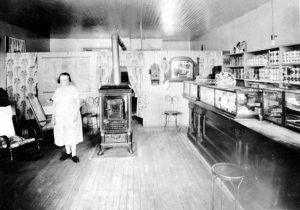
Lulu Brittingham on the first floor of the building where she lived and ran a small store. The building was originally a saloon run by Sam Mongerson.
During these years, Blues music played an essential part in the Paxico’s annual celebration of Emancipation Day. By 1890, there were 250 people living in Paxico, and “one of the busiest days each year was on August 1st and the celebration of the black community all over eastern Kansas as several hundred people came to Paxico from neighboring towns on the train to partake in the festivities.” A lodge hall, free of segregation, was constructed for social gatherings where large dances and picnics were held frequently and the neighborhood and visitors enjoyed “music, beer, barbeque, and baseball for both men and women and black and white.”
One musical refuge of the community, for both black and white, was a local tavern called “Lu Lu’s” owned by Sam Mongerson. Located on Main Street on the outer east side of town, the building served as a bar and billiard hall and one of the only licensed brothels in Kansas from 1887 to 1927. With many of the African American men employed at the stockyards with the Rock Island railway line, the tavern served as a relaxing venue for retired railway workers to play their blues music. While many of the illegal clubs of Kansas City flourished, virtually mocking the “Prohibition” of alcohol, the booming industry of liquor and gambling turned out to be a monetary opportunity for black musicians who also capitalized in the entertainment business.
This cultural tradition continues every year during Paxico’s annual Blues Festival where celebrated big city blues are featured in a small-town setting. Having a reputation for highlighting rising stars and past headliners, the event draws thousands of visitors on the third Saturday in September each year.
In Paxico Catholic German-Americans were culturally dominant, but they interacted with Protestant German-Americans, Midwestern, and African-American members of the community.
In March 1892 the Anderson Company sold the general store to William Bolton. who he operated the business as Bolton Brothers until October 1900 when he sold it to Charles J. Glotzbach. Afterward, the Bolton brothers retired to farms they had purchased in the area. The store was then known C. J. Glotzbach and Sons. Twelve rooms above the store became the Glotzbach residence. In 1907 the Glotzbach family added a furniture display and undertaking business in a new storeroom constructed to the north of the original building at 107 Newbury Street. The business was widely known for its elaborately decorated horse-drawn hearse.
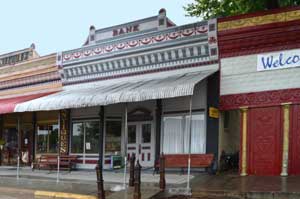
The State Bank of Paxico was built in 1907. Today, the building, which is an antique store, is part of the Paxico Historic District. Photo by Kathy Weiser-Alexander.
The same year, the State Bank of Paxico was established north of the Glotzbach store at 109 Newbury. The Enterprise commented that the new Paxico State Bank was one of the neatest and best-arranged bank rooms in the county with ample room for customers, cashier, and a commodious private room in the rear for the directors. The bank operated until 1932, at which time the building was utilized for other purposes. Today, it still stands as part of the historic district.
After an earlier attempt to incorporate in 1908 failed, Paxico was finally organized as a city of the third class in 1914. By that time, the town boasted 21 businesses and a population of about 250 people with its economy primarily supported by the production of the rich valley farmlands and the cattle business.
By 1912, Robert Strowig’s mill had become less profitable and operations ceased. Afterward, the mill deteriorated quickly; the roof blew off, in 1935 half the dam was destroyed by floodwaters, and the 1951 Flood took out the rest of the dam and the southeast corner of the building. In 1972 the last of the mill’s walls were pulled down.
In 1920, Paxico had a population of 249 and electric lines were installed the following year, eliminating the need for gasoline street lamps. In 1925, the Fire department was organized at the peak of the town’s socio-economic development.
Afterward, the Great Depression took its toll on businesses and residents. During this time, “poor crops and slow notes” forced the closure of the State Bank on February 2, 1931. Later, the building was used as a meat market and tavern.
After World War II, the population of Paxico and its business activity continued to decline. In 1945, Paxico’s population was 205, and unfortunately, in the next years, several of the town’s commercial buildings were demolished or destroyed by fire.
Recession, limited economic opportunity and better transportation all contributed to the decline of Paxico as a small market town serving the farmers of northern Wabaunsee County. Even in the prosperous years after 1945, the population and business of Paxico continued to decline. Although the Glotzbach family maintained the general store until 1960, the mix of goods in the store changed as more and more business was conducted in larger towns such as Alma or Topeka.
In the next years, the general store was sold several times until it was purchased by Steve and Kathy Hund in the 1970s and opened Mill Creek Antiques, which has been operating for more than 40 years. Located above the old general store is the Paxico Inn that provides several rooms available for guests.
Steve Hund Jr., owner and descendant of one of Paxico’s first German founders, began selling antique wood-burning parlor stoves and bought the building to house his collection of American and Victorian antiques.
The Chicago, Rock Island and Pacific Railway shut down in 1980 and was reorganized as the Oklahoma, Kansas and Texas Railroad, which merged in 1988 with Missouri Pacific Railroad. In 1997, it merged with the Union Pacific Railroad which still operates today. Most locals still refer to this railroad as the “Rock Island”.
Today, the Paxico Historic District includes some of the most significant historic buildings in the town’s small business district. It includes four adjacent commercial buildings in a row on Newbury Avenue. To the east on Main Street is a separate two-story commercial block (Mungerson Billiard Hall, 218 Main Street) that also is associated with the district.
Paxico is called home to about 215 people today. This beautiful and unique small town is located one mile North off I-70 at Exit 333.
Compiled and edited by Kathy Weiser/Legends of Kansas, updated May 2020.
Also See:
Wabaunsee County Photo Gallery
Sources:
Blackmar, Frank. W.; Kansas: A Cyclopedia of State History, Volume I, Standard Publishing Company, Chicago, IL 1912
Hiegert, Doug; A Tale of Three Towns: Old Paxico, Newbury and Paxico, Wabaunsee County Museum, 2016.
Kansas Memory
Paxico Historic District Nomination
Saenger, Allana; African American Cultural History Relative to Blues Music and Its Origins in Paxico, KS, 1890-1930; Kansas State University, 2009
Wikipedia

